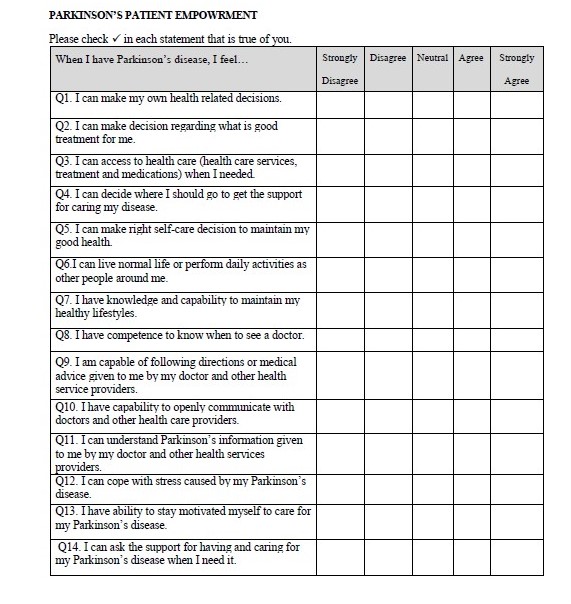Session Information
Date: Monday, October 8, 2018
Session Title: Parkinson's Disease: Cognition
Session Time: 1:15pm-2:45pm
Location: Hall 3FG
Objective: To develop a valid and reliable measurement scale of Parkinson’s patient empowerment index (PPEI).
Background: Patient empowerment concept has been used as part of patient self-care strategies in health care system. Based on psychological health empowerment[1], it was defined as a cognitive state of perceived competence and perceived control to manage individual’s own health. Due to the unpredictable symptoms of Parkinson’s disease (PD), persons with Parkinson’s (PwP) tend to have a diminished sense of empowerment [2]. However, we still lack of instrument to measure empowerment which can assist health care providers to find the strategies to increase empowerment level in PwP.
Methods: The methodological study of PPEI development included literature reviews, translation, pilot study and main study. The main study was conducted among 128 PwP at specialized tertiary care center. The first step of analysis was to detect the items component loading with exploratory factor analysis (EFA) and then conduct the second step of analysis with confirmatory factor analysis (CFA) using AMOS 20.0, respectively.
Results: Content validity of PPEI was supported by the Index of Item-Objective Congruence (IOC) by five experts. Through examination by EFA, we used 14 items (Figure 1) and adopted two analytics factors. These two factors were perceived control (Q1to Q5) and perceived competence (Q6 to Q14). Cronbach’s alpha coefficient for overall scale was 0.897 and the alpha coefficients for subscales were 0.881 and 0.771, respectively, which indicated the acceptable internal consistency of the scale. However, the results of CFA indicated poor model fit Goodness-of-fit x2/df = 2.968, AGFI = 0.734, CFI = 0.821, RMR = 0.040, RMSEA = 0.124. The unidimension of PPEI was also explored and showed high internal consistency (0.897), the high relationship between two subscales (r = 0.84) and all factor loading values ranged from 0.47 to 0.83.
Conclusions: Our study suggested that the unidimension of PPEI with sum scores of perceived control and competence was the suitable model to measure Parkinson’s patient empowerment level due to the high internal consistency reliability and acceptable validity.
References: 1. Menon, S.T., Toward a model of psychological health empowerment: implications for health care in multicultural communities. Nurse Education Today, 2002. 22(1): p. 28-39. 2. Reese, S.L., Psychosocial factors in Parkinson’s disease. Dis Mon, 2007. 53(5): p. 291-5.
To cite this abstract in AMA style:
P. Viwattanakulvanid. The development of an instrument for measuring Parkinson’s patient empowerment [abstract]. Mov Disord. 2018; 33 (suppl 2). https://www.mdsabstracts.org/abstract/the-development-of-an-instrument-for-measuring-parkinsons-patient-empowerment/. Accessed April 10, 2025.« Back to 2018 International Congress
MDS Abstracts - https://www.mdsabstracts.org/abstract/the-development-of-an-instrument-for-measuring-parkinsons-patient-empowerment/

